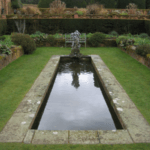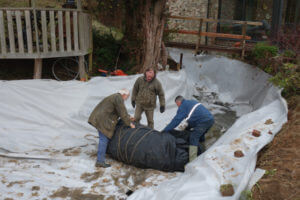As with all home and garden projects careful planning is required. So, in this article I aim to share all the steps you need to put in place including a project budget if you are going to include a pond liner, underlay, pond pump, filter, aquatic plants, fish and other finishing touches to your build.
With any pond build, the first and most important step is to decide what the purpose of your pond will be. Is it to attract wildlife, to keep gold fish, home Koi Carp or grow aquatic plants. Are you going to use natural or a mechanical water quality control system?
- for aquatic planting you will need to add a stepped base or shelf to your design plan. The shelves can be used to accommodate marginal plants of varying heights or to place planting baskets. Shelves make it easier to remove plants to cut back at the end of the season and for general pond maintenance. The design and planning for this type of pond is much like the steps you would take when planning what to plant in a flower bed so that choice works together in a creative fashion.
- for a fish pond, water volume is an important factor when considering design and size. The bigger the pond, the easier it is to maintain healthy water levels. Goldfish require a pond of at least 5 meter square and a depth of no less than half a meter – or a volume of 3000 litres. Koi require a minimum of 5500 litres – or minimum pond size of 2.5m x 2m x 1.2m. There is also a maximum depth – a Koi pond shouldn’t be deeper than 3 meters because sunlight won’t penetrate sufficiently to promote the vital growth of healthy algae. Koi are big fish and need a large volume of water. They also produce high amounts of waste. For both those reasons, a steep or vertical sided pond is recommended. It guarantees the largest volume of water for the space occupied by the pond and steep sides don’t accumulate waste materials and debris that can release harmful ammonia.
- a wildlife pond is probably the easiest type to build and maintain. No retainer wall or brick work involved. A wildlife pond just needs a sloping edge so small creatures such as frogs can easily enter and get out.
- a natural pond is one in which the water, soil, plants, and animals all live in harmony. There is no man-made intervention such as a pond liner to contain the water or pond pump to aerate the water.
What size pond?
The bigger the pond the easier it will be to maintain relative to a small shallow water feature. This is because a small pond gets warm quicker in summer and is more likely to freeze over in winter relative to a bigger and deeper pond. However, there are solutions to every situation – when the temperatures rise during the summer months add extra aeration to your pond – use an air pump to achieve this and make sure your pond receives sufficient shade. Use a pond thermometer if you plan on homing fish and keep an eye out for any signs of distress. The lethal water temperature for Koi and goldfish is reportedly 90 degrees F. The higher the water temperature, the less dissolved oxygen it is capable of holding. Fish have a greater demand for oxygen at higher temperatures so the distress they show is due to breathing difficulties.
Pond location
The next step is to decide where to position your pond. A formal pond into which a box-welded pond liner is fitted can be raised off the ground or dug into the ground. It is about deciding which fits best with your garden size and overall landscape design.
- site a pond on level ground – this will also help avoid rainwater run-off, which could bring with it fertilisers carried into your pond. Added nutrients will have a negative impact on water quality.

- ponds need 50 to 70% of the water to be in shade. This can be achieved by building your pond under a pergola (or building a pergola to go over your pond) or shaded in relation to the position of your pond to a garden wall or house. Include floating plants can also provide the necessary amount of shade ( fish can’t breath if too much of the surface is covered by aquatic plants). Building your pond too close to a tree to provide the necessary amount of shade is possible although you will have to keep on top of skimming off all the fallen leaves before they sink to the bottom.
Pond design
Now that you know what the purpose is for building your garden pond, the size that we best fit in the space you have available and where you are going to position it – the next step is deciding on design. A box welded pond liner doesn’t restrict you to a geometric with variations of square or rectangular layout. It is possible to be more creative with your design and still have your pond lined without creases or folds to the pond liner. The main criteria is that the design needs to include vertical sides.
Use a length of rope to play around with different shapes until you come up with one that will work in your garden and against the backdrop of your surrounding landscape.
Building your pond
A raised pond can be built using bricks, concrete blocks or railway sleepers. Sunken ponds require digging. The soil dug out can be used in flower beds or to landscape your garden. Once you have finished digging and are fully satisfied with the layout and depth you will need to remove as many of the stones and rough gravel as possible so as not to damage your pond liner. Measure the widest width, the longest length and the deepest point of your pond. These dimensions are necessary to calculate how much pond liner and protective underlay you will need to order.
Installing underlay and pond liner 
It is always best to tackle the job with another pair of helping hands. First unfold the protective underlay and line the hole dug for your pond. Then, with great care unravel the pond liner and, with help lift and place over the pond. Allow your pond liner to sink into the deepest area of your pond. Step barefoot into your pond to carefully push your pond liner into the contours. Pleat and fold as neatly as possible into the corners. Don’t be tempted to cut any excess pond liner until the pond liner has ‘settled in’ and you have filled your pond with water.
The final step is to decide whether you are going to use natural means of aerating and maintaining water quality or mechanical by way of a pump and filter. The role of a pond pump is to keep the water moving and by so doing it add oxygen to it. A filter added to the pump will remove debris. This is particularly important when keeping fish because their faeces, if left in the water increase the nitrate levels. This in turn affects water quality.
Goldfish and Koi excrete waste into the water in the form of ammonia from their gills and nitrate in their faeces. And, algae grows in ponds where there are high levels light and nutrients. When nutrient levels get high enough, algae takes over the pond and chokes everything else out. Ponds lined with a pond liner means there is a lack of soil in the bottom therefore few micro-organisms compared to that of a natural pond. There are also fewer surfaces for mico-organisms to attach to. Therefore you have to create an artificial place for the microbes to live. A filtration system can be used to provide a surface for the micro-organisms to live on. Microbes take-up waste animal and plant matter as they float around in the water keeping the water clear of nutrients needed for algae to thrive.
Building a pond in your garden is such a rewarding challenge to take on. The finished product will provide you with endless enjoyment so I hope these steps help you to get to work on your plans.





